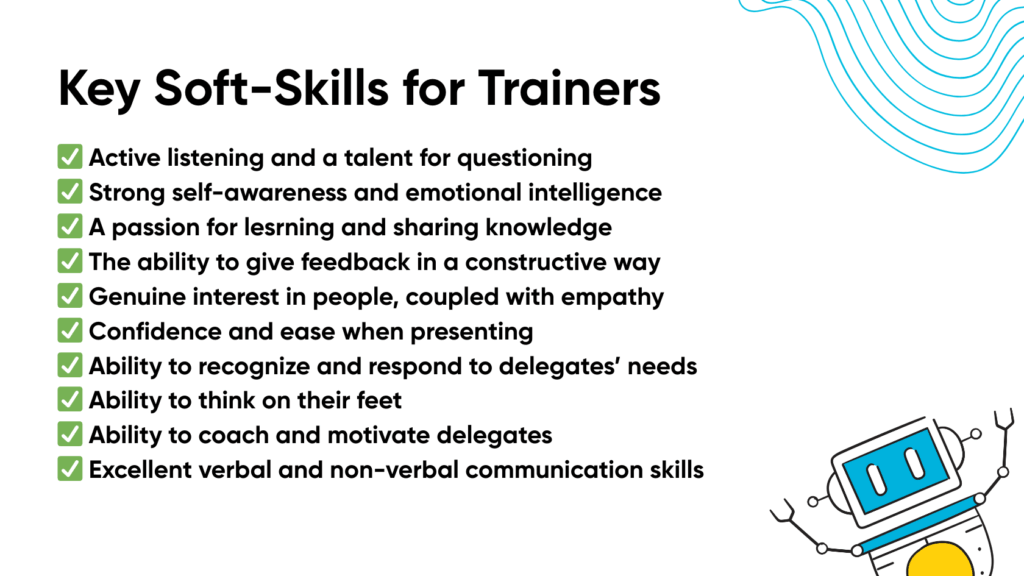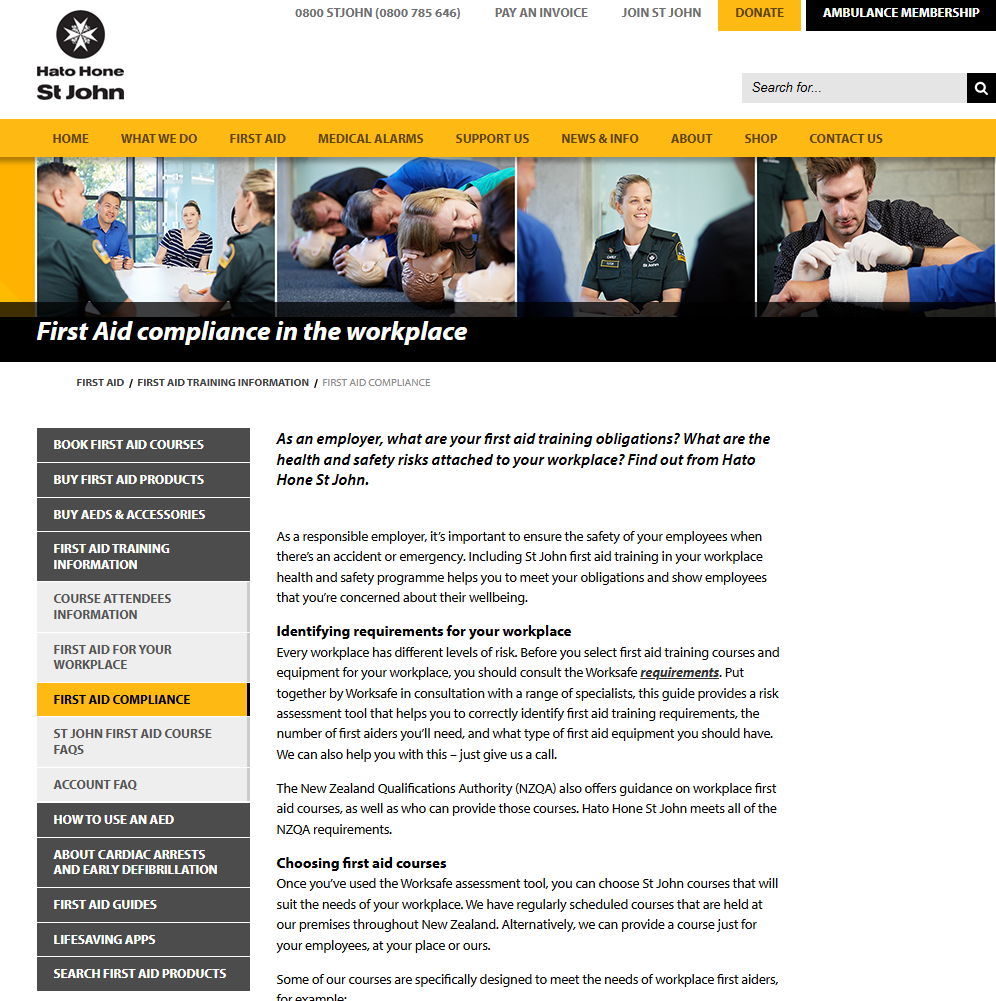Recently updated on May 21st, 2025
Starting a training business gives you the opportunity to tap into the massive global demand for training in the growing training industry.
According to recent industry reports, the global corporate training market was valued at $361.5 billion in 2023 and is projected to reach $805.6 billion by 2035, growing at a compound annual growth rate (CAGR) of 7%.
Aside from a piece of this pie, there are plenty of other reasons you may be looking at starting a training business, including:
You want to build a credible, independent brand around your expertise – Not just teach, but lead a category and set a standard in a space. This is particularly true if you have been delivering one type of training for a while and have built up a large pool of expertise that you want to share.
You see a gap in the market – Often a training professional spots a gap in the market, such as a group of learners that are underserved.
That was exactly the case with Arlo customer Tammy Banks, Co-Founder of Transform Your Training. Tammy and her co-founder Faye Fox founded the company, social-impact focused training provider, to address service delivery needs in the criminal justice sector.
(You can read more about Tammy’s story here)
You care about real-world outcomes for learners – Sometimes training topics can be abstract, and you may well spot that you can serve learners in your area of expertise through offering training that’s highly applicable and practical to the industry/niche you work in.
Whatever your reason for wanting to start your own training business (or any new business venture) its important to have an idea of the key steps you’ll need to take. This is by no means an exhaustive list, and each situation can be different, but by the end of this guide you should have an idea of some of the most important aspects you’ll need to consider
These tips are based on working with thousands of training providers who’ve used Arlo as their training management platform of choice to build a successful business.
1. Determine Your Niche
Selecting a niche can be a straightforward process for some, and a bit more complex for others. For example, as we touched upon, if you’ve been working in a field delivering training on a particular topic e.g. first aid training and this is the field you want to stay in then niche selection is easier.
You can use these examples from Arlo customers as inspiration and to get some ideas flowing:
Tom Durham co-founder of UK First Aid Training Company, moment of inspiration struck after attending multiple first aid courses: “After attending my fourth or fifth first aid course, I thought to myself, ‘I could teach this,’” Tom told us in our Arlo Change Makers piece focussing on his training journey.
Or, Kim Turner who during her time working as a dispatcher and supervisor at the San Jose Police Department, where she was also a member of the Dispatch Response and the Training Unit, and her experiences here led her to found Kim Turner LLC – a training and consulting company dedicated to changing public safety training for the better and bridging the gap between 9-1-1 and field first responders through high-quality training and consultancy.
If you haven’t worked directly in a field, but still have a passion for it, then this can be enough. Some tips on finding your niche if you don’t have direct experience in it:
Align with your interests and transferable skills
Start by identifying subjects you’re passionate about and causes that matter to you. Consider the skills you’ve gained in other roles, such as communication leadership or problem solving.
Connect with experts in the field
If you have passion for a particular area its never a bad idea to start connecting with others in the field.
You can do this through industry events, joining paid communities such related to the field, or simply reaching out to others on LinkedIn asking for advice.
Validate through action
If you’ve decided upon a niche and want to test demand, look to run a pilot workshop, webinar or online course. Use this as a chance to gather feedback and refine your approach.

2. Carry Out Market Research
Carrying out market research is of course a huge undertaking, so you’ll want to break this step down.
The essentials of beginning to get an idea of your opportunity include:
Who needs this training – Which industries, roles or business types are required (or highly incentivized_ to invest in the type of training you want to offer.
What their current solutions are – How they currently meet those needs, who they’re buying from, and what their pain points are
What regulations or standards apply – Whether compliance is mandated, recommended or voluntary, and what those rules require.
How training is typically delivered – Preferences for online, in-person, hybrid, self-paced etc.
What people are searching for – Understanding what language, keyword, and queries are used when looking for training providers
Who your competitors are – Who’s already serving this market, what they charge, how they deliver, and where there may be gaps or unmet needs.
For example, lets say I wanted to start a first aid training company specializing in helping businesses stay compliant with workplace safety regulations.
I’d start by identifying which sectors are legally required to provide first aid training, such as construction or manufacturing, by reviewing government and regulatory sources.
Next, I’d reach out to HR managers and compliance officers in those industries via LinkedIn or email surveys, to ask how they currently manage training, how often they renew it, what challenges they face, and how satisfied they are with their current providers.
I’d also run a competitor analysis, reviewing training companies in the space, noting their pricing, course formats and standout features. If I noticed that a few providers offer mobile-first or bilingual options, that might highlight an opportunity to differentiate my programs from the competition.
I’d supplement this with keyword research (via tools like Google Trends, or an SEO tool like SemRush) to see what terms people are searching for e.g. “first aid compliance training online”.
I could then use all of this information to begin crafting a specific, value proposition, such as: “Fast, affordable, regulation-ready first aid training for high-risk businesses, delivered in English and Spanish”.
All of this research contributes to a focused market analysis that helps define your position and competitive advantage.

3. Develop a Business Plan
Once you’ve conducted initial market research, its time to start thinking about your business plan. We’ll just layout the essentials for what it should include here, you may well want to seek professional advice when crafting such a specific, and important document.
Some points to consider though are:
Who is your economic buyer?
Your economic buyer is the individual or department responsible for purchasing training services or managing budgets.
What training pain point are you solving?
Identify the key challenges your audience faces such as skill development, or regulatory compliance.
What’s your offer’s business value?
How does your training create measurable business outcomes? You’ll want to be specific here.
For example, if the training business you were starting focusses on communication skills training in the workplace, some specific outcomes might be:
Reduced misunderstanding: Training employees in clear communication helps prevent costly mistakes and delays. For example, after communication training, a team may experience fewer project delays due to miscommunication during handovers or meetings.
Improved customer satisfaction: Effective communication allows employees to address client concerns more efficiently. With better communication skills, customer service teams, are more likely to resolve issues quickly.
Your training programs should be designed to produce measurable outcomes, helping learners apply newly acquired skills directly in their roles.
What’s your go-to-market strategy?
Your go-to-market strategy should outline the best marketing strategies for reaching your ideal clients, whether through digital ads, referrals, or partnerships.
What are your fixed and variable costs?
Identify your primary costs, such as facilitator fees, any software you’ll need such as training management software, insurance and content production. Your fixed and variable costs will be very specific to your use case so just take this as an example.
At this stage you’ll also want to define your business structure, whether sole proprietorship, partnership or limited company, as it will affect your taxes, liability and operations.

Manage training with Arlo
Find out more about how the Arlo training management system can reduce administration and streamline processes.
4. Decide on Your Pricing Model
You’ll need to choose how you’ll charge for your training services, and that means picking a pricing structure that aligns with how training is delivered and bought in your niche.
Here’s a breakdown of some different pricing models you may want to consider:
Per Learner (Per Seat)
- Commonly used for open courses, virtual instructor-led training, and elearning
- Example: $95 per learner for a scheduled Zoom virtual course
- Best for Scaling delivery, predictable margins, low-touch course enrolment.
Per Session or Per Day:
- Commonly used for onsite or bespoke in-house training
- Example: $950 per half-day session for up to 12 learners at a client’s site.
- Best for: Training providers who deliver on-site training for clients.
Tiered/Volume-Based Pricing
- Often this pricing model offers discounted rates based on the number of learners or sessions booked.
- Example: $95 per learner for 1-9 seats, $85 for 10-19 etc.
- The benefit of this pricing method is that encourages larger bookings, and long-term client relationships.
Annual or Quarterly Retainers
- A set fee for ongoing access to training delivery or consultancy
- Example: $5,000/year for up to 10 training sessions, including planning support.
- Useful for clients with recurring, or unpredictable training needs.
Subscription or License Access:
- Common for elearning or blended models.
- Example: $30 per year for access to a training platform.
- Work well for low-cost, high-volume, self-paced learning offers.
Blended/Hybrid Models
- Mix of formats and pricing (e.g. elearning + in person workshop_
- Example: $150 per learner for a package that includes online pre-work, a live virtual session, and follow-up resources.
5. Decide on a Delivery Format
The next piece of the puzzle is deciding on how your training will be delivered, and really you’ll want to prioritize whichever format best suits your content.
Some obvious, but key points to remember:
- If the training you teach is hands-on, and practical, or in-person elements are required for certification use Instructor-Led Training.
- If live interaction matters in the training you teach, but it being in-person isn’t essential, then consider virtual instructor led training.
- If the training you teach is repeatable, and can be conducted at a learners own pace then use self-paced learning.
Its often the case that you’ll use a mixture of delivery formats. And you’ll most likely use different ones within the same course.
A great example of how this works is shared in our Ultimate Guide to Instructor-Led Training by Tammy Banks. Tammy explains a recent example of how Transform Your Training had to do exactly this for a client:
“We recently worked with a physiotherapy company that has offices all over the country. They have managers for all their offices, and they also have clinical leads. And they wanted to enroll all of them in our leadership training program.
So, to effectively deliver the program we decided to completely tailor the structure of the course to their needs. Everyone comes together face to face in London for a full day, and then after they have fortnightly 90 minute live online sessions.
Alongside the live sessions delegates have their own elearning modules to work through, and the elearning modules directly feed into what they’re going to learn in the live sessions. The facilitator has access to a portal where they can see how each delegate is progressing through the self-paced modules.
Delegates are also part of an online community where they can discuss what they’re learning with one another and collaborate. We then have another face to face session at the end of the course to celebrate everyone completing the course”.

6. Create your Training Materials
When you know your preferred format its time to create your programs and materials. The key decisions you’ll have to make at this stage include:
What’s the structure of your training offer?
Before building materials you’ll need to decide on the structure of your programs. Will they be single sessions? A multi-part course, or does the program require ongoing development e,g. are quarterly or annual refreshers required?
Will you build materials yourself or bring in a learning designer?
This decision will affect your training program’s quality, scalability, and time-to-market.
If you’re training is highly subject specific, and you have deep expertise in the field, you may be able to create your own content. Particularly if you’re building short, practical sessions.
If you’re planning to build scalable programs (e.g. multiday, blended or online courses) that need to be engaging and designed for long term retention you may need to think about hiring or consulting with an instructional designer.
They can help you:
- Structure your program into logical, outcome-driven modules
- Choose the right mix of content formats (e.g. video, scenario-based practice sessions, group work)
- Build in opportunities for spaced repetition, feedback and assessment
- Make sure your programs are aligned with best practices e.g. they are tailored to your client, apply to real scenarios learners will face, match different learning styles and more.
What materials do you need — by format?
Here’s a quick overview of some of the different training materials you may need for different formats:
- In-person ILT: Slide decks, facilitator notes, printed handouts, activities, assessment checklists
- Virtual ILT: Shared screen decks, break out room guides, digital handouts
- elearning: Interactive quizzes, certificates, checklists, clickable hotspots, videos
- Blended: Pre-course materials, live sessions, follow-up tool kits, further reading.
How will you maintain and manage materials over time?
Your training content won’t stay current forever. Industry standards, client requirements, and delivery formats will evolve. You need a plan to keep materials accurate, consistent and easy to update.
You’ll need to decide where you want to store your materials. This might be in a platform such as a TMS or LMS, but if you’re just starting out one of these platforms may be more than you need.
Good, organized document hygiene goes a long way here.
Avoid saving different versions across desktops, email chains, or personal drives. Instead, use a structured system, like Google Drive with version control folders, Notion for program maps, or a training management system if you’re scaling.
Also, you should create a simple process for reviewing and updating content.
This could outlook like:
- Keep a log of what’s been updated, when and why. This is particularly important to track if you deliver regulated or auditable training.
- Set a regular review cycle (every 6-12 months)
- Flag client specific customizations so you don’t delete or overwrite them.
7. Set Up Your Client Acquisition and Booking Systems
Once your training programs are ready, you need a for clients to find, enquire, book and pay, without you manually managing every step.
The key decisions you’ll need to make are:
- How will potential clients find and enquire about your services? (e.g. direct outreach, SEO, referrals, directory platforms)
- Will you take booking manually, or automate course booking through a training management system?
- How will you handle payments – upfront, invoiced, staged?
Whichever method or platform you choose your systems should be simple and seamless for prospective clients to navigate from discovery through to payment.
(Note: If you need a platform to handle payments, invoices, and staged payment options, Arlo lets you automate invoicing, track payments, and offer flexible checkout options like deposits, discounts and vouchers – learn more about Arlo’s course registration and payments features here.)
8. Test Your Training Programs with a Pilot Group
Before rolling out your training at scale, it pays to validate that it works in practice. Testing lets you improve your content, fine-tune your delivery, and catch issues that only show up in a live environment.
Think about:
- Who will you you pilot the training with? This may include trusted clients, industry peers or a focus group.
- What specific elements are you testing e.g. content clarity, learner engagement, timing, delivery logistics?
- How will you collect structured feedback and turn it into actionable improvements?
The tools and methods you can use to do this include:
- Run a controlled pilot and deliver your course to a small audience representative of your target clients.
- Use structured evaluation, you can combine learner feedback forms with observational notes and facilitator reflections.
- Track performance outcomes, you can include quizzes, assessments, or skills demonstrations if outcomes matter.
9. Finalize Your Marketing Strategy for Launch
Your marketing strategy should help you get in front of real buyers, show the value of your training offer, and convert interest into bookings. At the launch of your training business, it’s best to try and keep things simple.
Here are a few tips and points to keep in mind:
Who exactly are you trying to reach?
Take some time to define the buyer role specifically, e.g. not just “businesses”, or “HR”, but job titles of your target buyer such as “Health & Safety Manager in a 20-200 person manufacturing firm.
What makes them buy?
Are there any real-world scenarios you can pinpoint where buyers are actively seeking the training you’re offering e.g. when does your target buyer decide on their training budget/make training bookings, are there any upcoming audits or compliance checks? Are there any significant policy or regulation changes upcoming?
Where will you find your target customers?
It’s best to focus on 1-2 lead channels when you’re getting started, and go from there. This could look like:
- Directly reaching out to target clients on LinkedIn
- Emailing local businesses using public directories
- Listing your training business on training directories
- Reach out to your network for referrals.
10. Have the Right Training Tools in Place So Your Primed for Growth
The amount of registrations, and the initial scope of your training business will determine what your tech stack will look like.
If you’re just running some small local courses where you’re taking under ten registrations a month, a simple setup using spreadsheets, manual emails, and basic payments tools like PayPal might be enough to get you started.
But if you plan on scaling beyond this, you’ll need a platform that can automate your training admin, handle bookings, manage communications and keep your operations running smoothly.
And that’s exactly what a platform like Arlo Training Management Software excels at.
It gives you everything you need to manage and grow a modern training business in one system:
Course Scheduling and Delivery Management
Create and manage face-to-face, live online, blended, and self-paced elearning courses in one place. Automate communications, presenter scheduling and session logistics.
AI-Powered Course Authoring
Create and deliver self-paced content, and track learner engagement. Deliver rich interactive learning experiences with videos, quizzes, assignments, pre-reading and microlearning modules, all available on any device.
Flexible Registrations and Payments
Accept online payments, offer deposits and staged payments, apply discounts and vouchers, and automate invoicing and receipts.
CRM and Real-Time Reporting
Track leads, client interactions, and course performance. Build tailored reports to monitor registrations, attendance revenue and more.
Training Websites that Convert
Use Arlo’s out of the box training website, free with your subscription, or integrate Arlo into your own training or course website. Update course listings automatically, publish ew courses at the click of a button and optimize for visibility and sign-ups.
Final Tips
Launching a professional training business hinges on strategic planning and focused execution.
The tips we’ve shared should have given you some things to think about the key tasks you’ll need to undertake before launching.
The key things to remember are:
- Identify a specific niche and undertake comprehensive market research to determine the opportunity size that exists within this market. From there define your ICP, value prop, and positioning.
- Formulate a robust business plan, design impactful training programs and select delivery methods suited to maximizing learner engagement and outcomes.
- Decide on what marketing strategies you’ll use to find your target customer, and implement any relevant tech solutions like a training management system.
- Take the time to validate your training programs to refine and test your offerings.
Try Arlo the #1 platform you need to grow your training business. Start a free 14-day trial today.
FAQs
Defining your target market can be a lengthy process. But you can start by identifying who will benefit the most from your training.
Your target market might be defined by industry, role, skill level, or geographic location. Once your target market is defined you can move onto other areas of focus such as beginning to design learning materials for your courses.
Your company description should clearly outline what kind of training business you plan to run, for example will it be an online training business, a training business running entirely self-paced learning, will you offer in person training to clients?
It’s important to get specific on the types of training, and courses you plan to offer, who you train (e.g. what industry, individuals or groups), and what makes your training business stand out.
As we mentioned above, the technology you’ll require depends on the scope of your business. If you’re just starting out and expect to just be taking a few registrations, a simple booking system, and tracking operations manually through something like Google sheets may be enough.
But if you’re expecting to be taking anything more than 50+ registrations a month, we’d recommend considering training management software. TMS will help you with everything from scheduling training courses, through to processing bookings, and taking payments.
